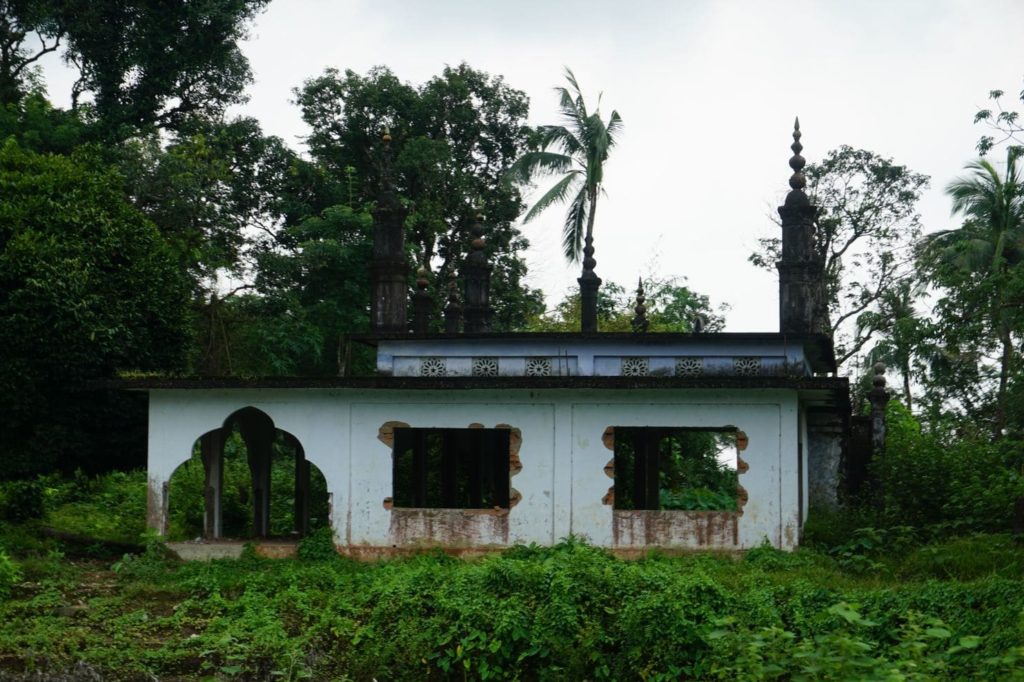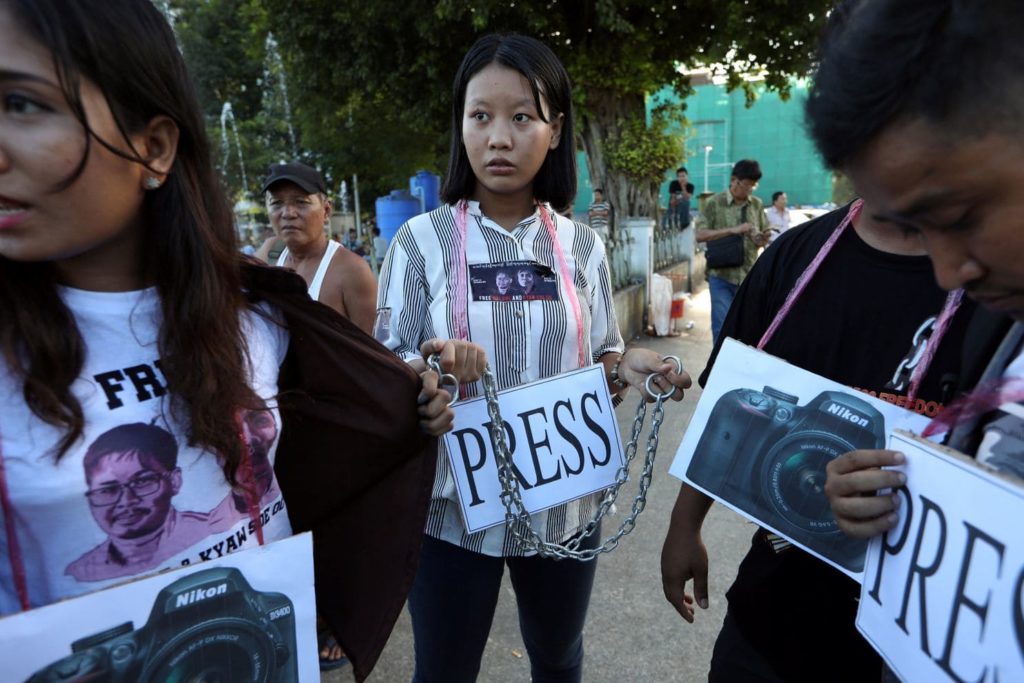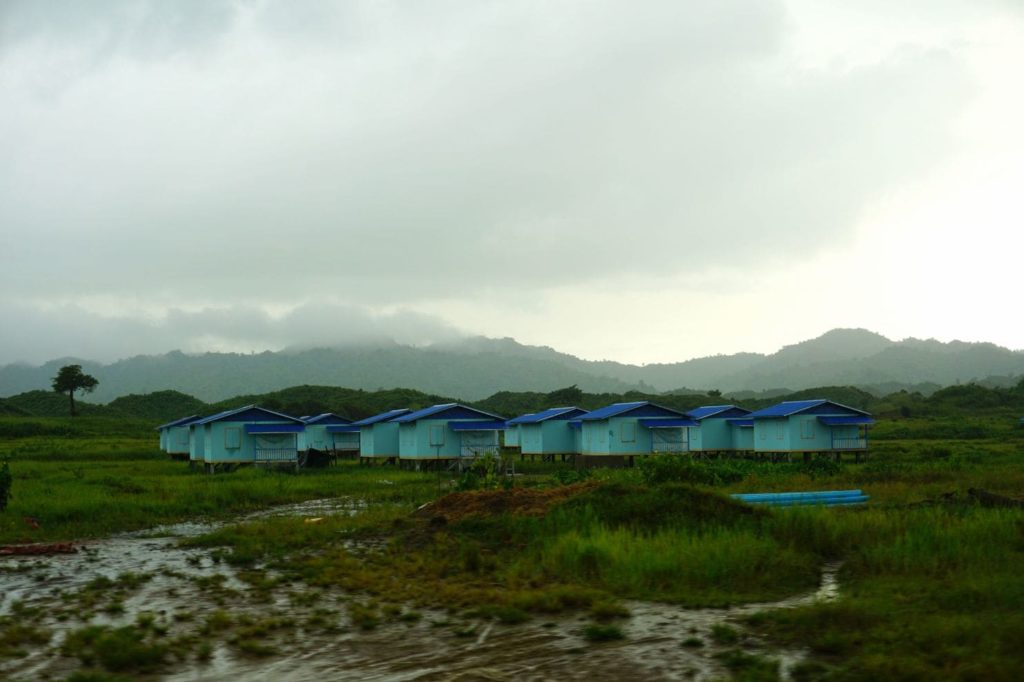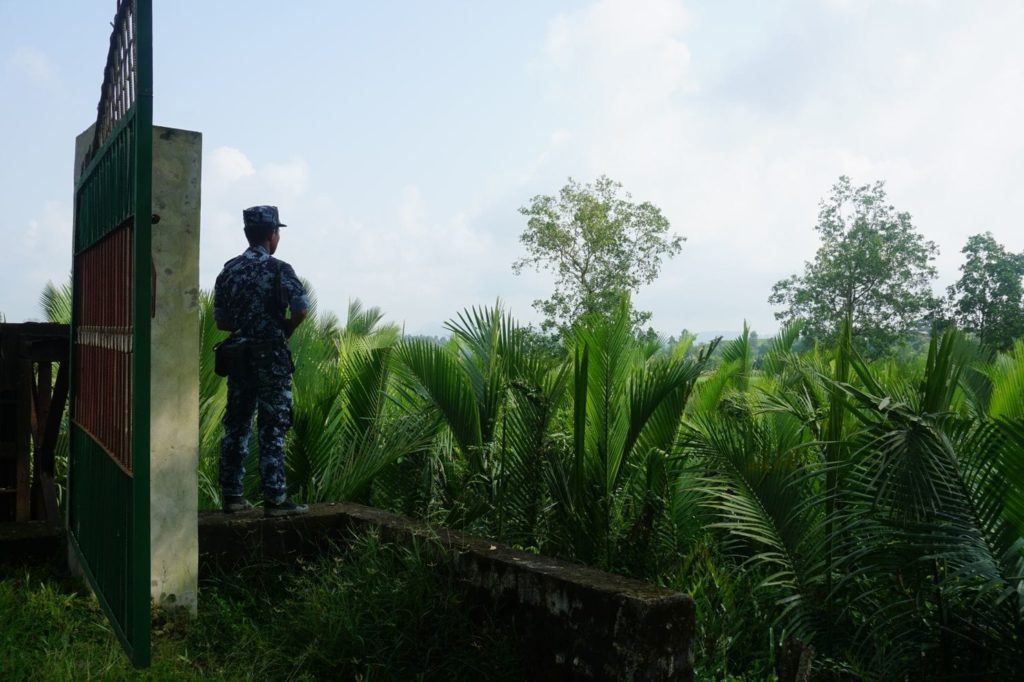The World Decries Myanmar’s Rohingya Abuses – Myanmar’s Reply: Denial, Defiance and Propaganda
ASIA-UPDATES ON MYANMAR ROHINGYA GENOCIDE, 15 Oct 2018
Shibani Mahtani – The Washington Post

The charred remains of a mosque here are among the few signs that hundreds of thousands of Rohingya once lived on this land. Military officers, with the help of locals, torched their homes and villages in a violent crackdown against the group last August. (Shibani Mahtani/The Washington Post)
9 Oct 2018 — Plainclothes police hovered around him. The elderly Rohingya man was too afraid to talk.
He was gathered with dozens of other men, staring blankly at journalists on a government-led trip Myanmar’s northern Rakhine state. He is among the 200,000 or so Rohingya who remain in this area, after more than 720,000 fled to neighboring Bangladesh during a campaign of terror at the hands of the military in mostly Buddhist Myanmar.
The U.N. rights commission said there was “genocidal intent” in Myanmar’s targeted killings, the razing of Rohingya villages and the mass flight of refugees to neighboring Bangladesh.
Myanmar leaders — including Nobel Peace Prize laureate Aung San Suu Kyi — have stuck with the claim that authorities were trying to quell an insurgency. The Myanmar propaganda push includes media trips, where a rotating cast of foreign journalists are led around Rakhine state in police convoys.
As one official put it: “How can it be genocide if Muslims are still here?”
The elderly Rohingya man eventually did talk.
But it came on a phone call to The Washington Post. He mocked the picture painted by Myanmar government minders on the lives of the remaining 300,000 or so Rohingya still in Rakhine.
Some homes in Muslim villages nearby his were torched as recently as this week, he said.
“We were told to tell [journalists] about how we are treated well here. They told us to talk about how we are living peacefully,” he continued, who spoke on the condition of anonymity because he feared for his safety.
He couldn’t bring himself to toe the line, but could not speak the truth, either.
“We know they are recording us,” he said.
Myanmar faces condemnation for persecution of Rohingya Muslims, but the government claims it was quelling an insurgency and wants the world to know their side. (Shibani Mahtani/The Washington Post)
Faced with international pressure and mounting calls for accountability over their atrocities against the Rohingya, Myanmar has mounted a defense of denial and defiance. Among the collateral damage is the reputation of Suu Kyi, which many see as tarnished and compromised.
For diplomats, aid groups and others, the attempt to shift the narrative is more evidence that Myanmar is unable or unwilling to correct long-standing discrimination against the beleaguered Rohingya.
It also underscores Myanmar’s resistance to bring any measure of accountability for the abuses and attacks committed last year, and to allow journalists to freely investigate the massacres there.
Two journalists from the Reuters news agency, Wa Lone and Kyaw Soe Oo, who reported on the massacre of 10 Muslim men at the nearby village of Inn Din, were convicted and sentenced to seven years in prison for violating the country’s secrets act.
Meanwhile, the Rohingya languish and grow more desperate.
“The bottom line is that there has been no noteworthy progress,” said one senior diplomat in Yangon, who spoke on the condition of anonymity because of the sensitivity of the issue.
The Myanmar government “still seems utterly unable or unwilling to understand what they would need to do to get themselves out of this mess,” the official said.
The government’s efforts have also failed to mask attempts by Myanmar to erase any indication that hundreds of thousands of Rohingya ever lived here. Buddhists and Hindus are moving into new homes built across the state, and Rohingya Muslims who remain in Myanmar say they continue to be harassed and extorted.
The United Nations, which has just begun to access some parts of northern Rakhine state, say communities there are isolated and fearful.

Myanmar press freedom advocates and youth activists hold a demonstration on Sept. 16 demanding the freedom of jailed Reuters journalists Wa Lone and Kyaw Soe Oo in Yangon, Myanmar. (Ann Wang/Reuters)
“Mistrust, fear of neighboring communities and a sense of insecurity are prevalent in many areas,” Andrej Mahecic, spokesman for the U.N. refugee agency, said Friday. Muslim communities there, he added, also are restricted in accessing education or health services.
International pressure is ramping up. In late September, the U.N. Human Rights Council voted overwhelmingly to create an independent body to expedite criminal prosecution of Myanmar generals over their treatment of the Rohingya.
Year after Rohingya campaign, Myanmar’s general are unapologetic
Their action followed a 444-page report from a U.N. fact-finding mission that explored in excruciating detail how the Myanmar military has followed a pattern of torture across other ethnic minority states, such as Shan and Kachin, and described the clearance operation against the Rohingya as having “genocidal intent.”
The U.N. findings could give prosecutors evidence for possible future cases in regional or international courts.
The Myanmar government and military has held firm to the explanation that their operation in Rakhine state was provoked by Rohingya militant attacks on police posts, but reports from both the United Nations and State Department indicate a degree of premeditation and coordination.
Myanmar says that it is ready to repatriate hundreds of Rohingya back to their homes.
At a refugee reception center close to the border, one Myanmar official boasted about new roads that Rohingya refugees will travel on from Bangladesh before turning over their identification documents for verification and eventually moving into new purpose-built villages to start their lives anew.

New model villages like these are being built all over northern Rakhine state, and in some, Buddhists are moving in -taking over land where Muslim Rohingya lived before 800,000 left amid a brutal military operation last year.
(Shibani Mahtani/The Washington Post)
“We are ready,” said Soe Tun, head of the relocation center, which is prepared to receive 150 returnees a day for five days of the week. “I don’t know why they wouldn’t want to come back.”
In the same breath, officials insist there are “no Rohingya in Myanmar,” and will compel those who return to adopt a verification document that makes no mention of the word Rohingya, who are excluded from citizenship rights.
The Myanmar government says the document will be a pathway to citizenship. But the Rohingya — who believe themselves native to Myanmar — say it is just another step to muddle the process and enshrine second-class status.
The document will call them “Bengali.” The Rohingya want to keep their identity and a recognition that they are full citizens native to the area.
“Much of the government’s narrative so far has been built on physical structures, like model villages, because those structures exist,” said Knut Ostby, the U.N.’s resident coordinator in Myanmar. “But the rights-based part has not been addressed yet.”
As a gesture of goodwill, Myanmar has promised to close squalid camps in the southern part of the state where 125,000 Rohingya live after a spate of violence drove them out of their homes six years ago.

A border guard officer stands watch at the Myanmar-Bangladesh friendship bridge. More than 800,000 Rohingya fled to neighboring Bangladesh during a military crackdown against the minority group last year. The Myanmar government says it is ready to repatriate Rohingya refugees, but diplomats and rights groups say the government has done nothing to secure their rights.
(Shibani Mahtani/The Washington Post)
Reporters were brought to one of the largest in Sittwe, and were told about a new hospital that would be built here. But no timeline has been given. Rohingya believe the possible camp closures will shift them to newly constructed villages without restoring freedom of movement, the ability to own shops and businesses again, or the right to go to schools or hospitals freely.
“They told us, we will relocate you, we will construct individual house for you, and we will give you rations of five years,” said a 22-year old Rohingya in the Sittwe camp. “But after that, what will happen? Wherever we walk, wherever we go, we get into trouble. Will that change?”
_______________________________________________
 Shibani Mahtani is the Southeast Asia correspondent for the Washington Post, covering countries that include the Philippines, Myanmar, Indonesia and Malaysia. She joined the Post‘s foreign desk in 2018 after seven years as a correspondent for the Wall Street Journal in Southeast Asia and later in Chicago, where she covered the Midwest.
Shibani Mahtani is the Southeast Asia correspondent for the Washington Post, covering countries that include the Philippines, Myanmar, Indonesia and Malaysia. She joined the Post‘s foreign desk in 2018 after seven years as a correspondent for the Wall Street Journal in Southeast Asia and later in Chicago, where she covered the Midwest.
Cape Diamond contributed to this report.
Go to Original – washingtonpost.com
DISCLAIMER: The statements, views and opinions expressed in pieces republished here are solely those of the authors and do not necessarily represent those of TMS. In accordance with title 17 U.S.C. section 107, this material is distributed without profit to those who have expressed a prior interest in receiving the included information for research and educational purposes. TMS has no affiliation whatsoever with the originator of this article nor is TMS endorsed or sponsored by the originator. “GO TO ORIGINAL” links are provided as a convenience to our readers and allow for verification of authenticity. However, as originating pages are often updated by their originating host sites, the versions posted may not match the versions our readers view when clicking the “GO TO ORIGINAL” links. This site contains copyrighted material the use of which has not always been specifically authorized by the copyright owner. We are making such material available in our efforts to advance understanding of environmental, political, human rights, economic, democracy, scientific, and social justice issues, etc. We believe this constitutes a ‘fair use’ of any such copyrighted material as provided for in section 107 of the US Copyright Law. In accordance with Title 17 U.S.C. Section 107, the material on this site is distributed without profit to those who have expressed a prior interest in receiving the included information for research and educational purposes. For more information go to: http://www.law.cornell.edu/uscode/17/107.shtml. If you wish to use copyrighted material from this site for purposes of your own that go beyond ‘fair use’, you must obtain permission from the copyright owner.
Read more
Click here to go to the current weekly digest or pick another article:
ASIA-UPDATES ON MYANMAR ROHINGYA GENOCIDE: